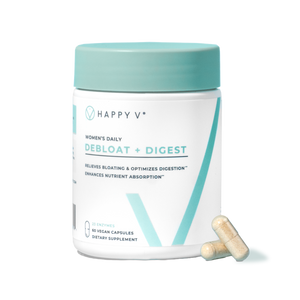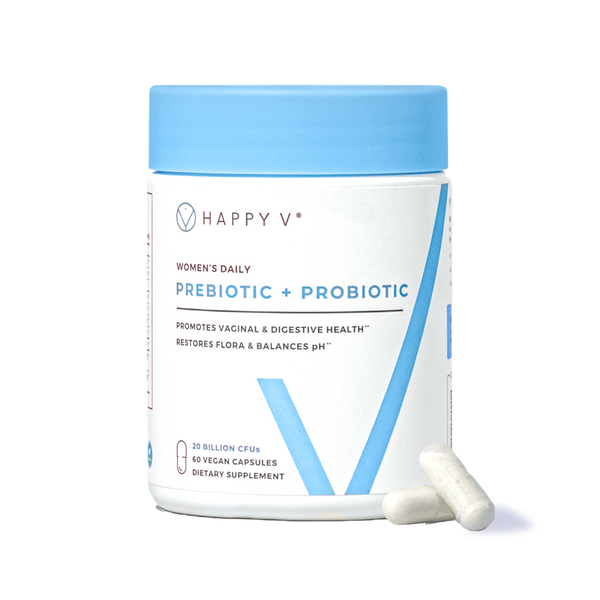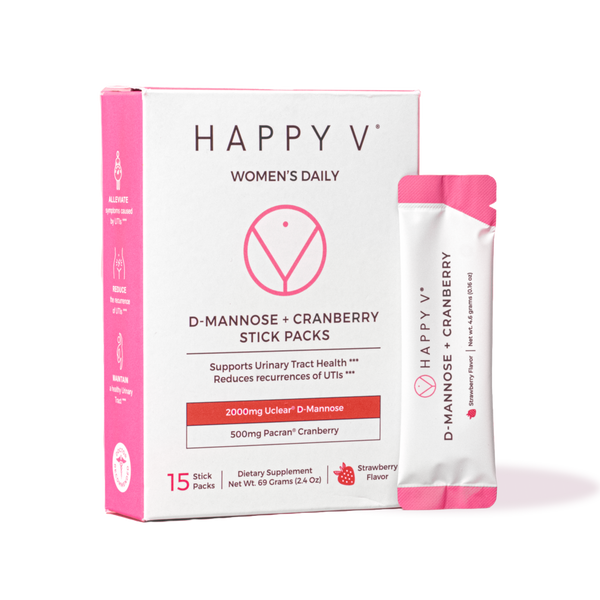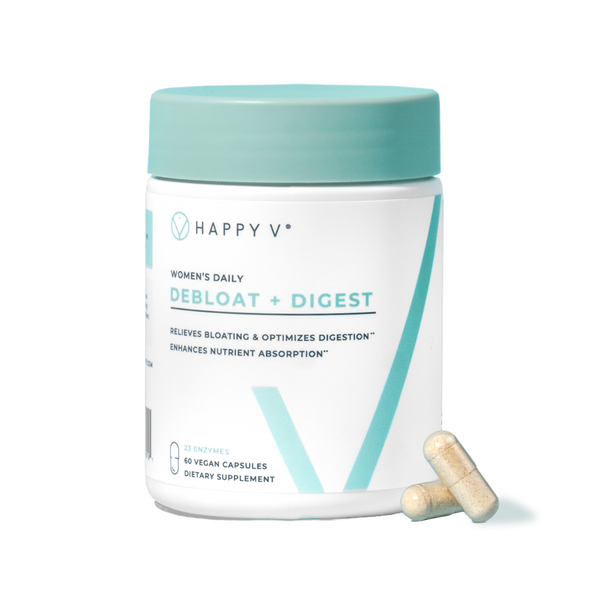- Fact Checked
- November 18, 2025
- 20 min read
Persistent Vaginal Issues? It Might Be Aerobic Vaginitis
Table of Contents
Table of Contents
When we talk about vaginal infections, bacterial vaginosis (BV) and yeast infections usually take center stage. But there’s another contender worth knowing: aerobic vaginitis (AV).
This condition often hides in plain sight because its symptoms mimic other infections, leading to missed or incorrect diagnoses. The problem? Untreated AV can cause more than just short-term discomfort. It can have lasting effects on your reproductive health.
Luckily, once you know what to watch for, you’re already ahead in getting the right treatment and keeping your vaginal microbiome happy.
This post is for informational purposes only and does not constitute medical advice. See full disclaimer below.
What Is Aerobic Vaginitis?
Think of aerobic vaginitis as the lesser-known cousin of bacterial vaginosis1: similar in some ways, but with its own distinct personality and needs. While BV gets most of the attention in women's health discussions, AV represents a completely different type of vaginal microbiome disruption that deserves recognition.
The key difference lies in the microbiology: aerobic vaginitis occurs when aerobic bacteria (aka microorganisms that thrive in oxygen-rich environments) begin to dominate your vaginal microflora2. The most common culprits include Escherichia coli (E. coli), Streptococcus agalactiae (also known as Group B Streptococcus), Enterococcus faecalis, and Staphylococcus aureus (S. aureus).
These pathogens aren't necessarily harmful in other parts of your body, but when they overgrow in your vaginal environment, they can cause significant disruption.
What makes this condition particularly concerning is the epidemiology. Studies show that the prevalence of aerobic vaginitis may be higher than previously thought, especially among certain populations, including menopausal women and those with compromised immune systems.
How Aerobic Vaginitis Affects Your Vaginal Health
Your vaginal microbiome is like a carefully orchestrated ecosystem, with lactobacilli playing the starring role as your natural protectors. These beneficial bacteria work around the clock to maintain vaginal health by producing lactic acid, keeping your vaginal pH in that optimal acidic range, and creating conditions that are hostile to infection-causing microorganisms.
When aerobic vaginitis disrupts this harmony, several cascading effects occur that can significantly impact your comfort and health, including:
pH Disruption and Microbial Imbalance
Without sufficient lactobacilli producing lactic acid, your vaginal pH rises above the healthy range3. This creates a more alkaline environment that becomes increasingly welcoming to aerobic bacteria and other pathogens. It's like rolling out the red carpet for organisms that should be kept in check.
Inflammatory Response and Tissue Changes
Your immune system recognizes these invading aerobic bacteria as threats and responds by sending inflammatory cells to the scene. While this immune response is meant to be protective, chronic inflammation can cause visible redness, swelling, and even painful erosions in the vaginal tissue. Studies show that this inflammatory process can significantly alter the vaginal epithelial cells, leading to even more irritation and discomfort.
Compromised Vaginal Barrier Function
The persistent inflammation associated with aerobic vaginitis can thin and compromise your vaginal lining4, making it more vulnerable to other vaginal infections and even sexually transmitted infections (STIs). This creates a concerning cycle where one problem potentially leads to another.
Long-term Microbiome Disruption
Once the delicate balance is disrupted, restoring the optimal ratio of beneficial bacteria takes time and often requires targeted and layered intervention. The longer aerobic vaginitis persists, the more challenging it can become to reestablish healthy vaginal microflora5.
Causes and Risk Factors: Understanding What Triggers Aerobic Vaginitis
The development of aerobic vaginitis rarely happens overnight. It's usually the result of multiple risk factors working together to disrupt your vaginal microbiome's delicate balance.
Understanding these triggers can help you recognize when you might be at increased risk and take preventive steps.
Hormonal Fluctuations and Estrogen Changes
Estrogen plays a crucial role in maintaining healthy vaginal tissue and supporting lactobacilli growth6. When estrogen levels drop, whether due to menopause, postpartum changes, breastfeeding, or certain hormonal contraceptives, the vaginal lining becomes thinner and produces less glycogen7. Since lactobacilli feed on glycogen8, reduced levels can lead to a decline in these protective bacteria, creating space for aerobic bacteria to establish themselves.
Menopausal women face a particularly increased risk due to the significant decline in estrogen that occurs during this transition. The resulting vaginal atrophy creates conditions that favor the development of aerobic vaginitis, which is why this condition is often seen in postmenopausal populations.
Antibiotic Use and Antimicrobial Disruption
While antibiotics like metronidazole, clindamycin, moxifloxacin, and kanamycin are essential tools in healthcare, they can inadvertently disrupt your vaginal microbiome9. These medications don't discriminate between harmful bacteria causing infections elsewhere in your body and the beneficial lactobacilli protecting your vaginal health.
After antibiotic treatment, opportunistic aerobic bacteria, including E. coli, Group B Streptococcus, and various streptococci, can quickly colonize the disrupted vaginal environment before lactobacilli can reestablish themselves.
Underlying Health Conditions
Certain medical conditions can significantly increase your susceptibility to aerobic vaginitis, including:
-
Diabetes and Blood Sugar Control10: Poor glycemic control can elevate vaginal glucose levels, providing additional nutrients that aerobic bacteria can use to multiply and establish overgrowth11.
-
Immune System Compromise: Whether due to chronic illness, medications, or other factors, a weakened immune system may struggle to keep opportunistic aerobic bacteria in check.
-
Chronic Inflammatory Conditions: Systemic inflammation can affect vaginal tissue health and alter the local immune response12.
Sexual Activity and Microbial Exchange
While aerobic vaginitis isn't classified as an STI, sexual activity can introduce new bacteria into your vaginal microbiome. If your microbial balance is already precarious, this additional bacterial load can tip the scales toward dysbiosis and the development of aerobic vaginitis.
Hygiene Practices and Environmental Factors
Douching remains one of the most significant risk factors for aerobic vaginitis14. Despite persistent marketing suggesting otherwise, douching strips away protective bacteria and can irritate the vaginal tissue, creating ideal conditions for aerobic bacteria to flourish.
Similarly, harsh cleansers, scented products, and aggressive washing can disrupt the delicate microflora balance that keeps your vaginal ecosystem healthy.
Clinical Features and Symptoms: Recognizing Aerobic Vaginitis
One of the most challenging aspects of aerobic vaginitis is that its symptoms often masquerade as other vaginal conditions, making accurate diagnosis tricky without proper testing. However, there are some distinctive clinical features that can help differentiate aerobic vaginitis from bacterial vaginosis or yeast infections.
Characteristic Vaginal Discharge
The vaginal discharge associated with aerobic vaginitis has its own distinct personality. Unlike the thick, cottage cheese-like discharge of yeast infections or the thin, fishy-smelling discharge of bacterial vaginosis, aerobic vaginitis typically produces a yellow or greenish discharge that may be thinner in consistency but more colorful than other infections.
This discharge might have a mild odor, though it lacks the characteristic "fishy" smell associated with BV. The color and consistency can vary depending on which specific aerobic bacteria are predominating in your vaginal microbiome.
Inflammatory Symptoms and Tissue Changes
What truly sets aerobic vaginitis apart is the intensity of vaginal inflammation it creates. You might experience:
-
Visible Redness and Swelling: The vulva and vaginal walls often appear noticeably red and inflamed, more so than typically seen with bacterial vaginosis.
-
Burning Sensation: Many people describe a persistent burning or stinging sensation that can worsen during urination or sexual activity.
-
Dyspareunia: Pain during intercourse is common due to the inflamed and sensitive vaginal tissues15.
-
Tissue Erosions: In more severe cases, small erosions or raw patches may develop on the vaginal walls, contributing to discomfort and vulnerability to other infections16.
Why Aerobic Vaginitis Gets Mistaken for Other Infections
One of the trickiest things about AV is that it doesn’t have a “signature” symptom that makes it easy to spot. Instead, it shares a lot of overlap with other vaginal infections, which means it can get mislabeled, misdiagnosed, or overlooked entirely. Here’s how the confusion happens:
-
Bacterial vaginosis (BV) and AV can both cause a higher vaginal pH and changes in discharge. The difference? BV discharge is usually thin, grayish-white, and often comes with a strong fishy odor, while AV discharge tends to be yellow or green with more visible redness and swelling.
-
Trichomoniasis (trich) is a sexually transmitted infection caused by the Trichomonas vaginalis parasite17. Like AV, it can lead to yellow-green discharge and irritation18, but trich discharge is often frothy, may have a stronger odor, and can cause spotting after sex. AV is bacterial, not parasitic, and usually develops from shifts in your own vaginal flora rather than direct STI exposure.
-
Yeast infections (Candida overgrowth) share symptoms like itching, burning, and inflammation, but their discharge is typically thick, white, and clumpy (more like cottage cheese) and usually odorless19. AV discharge is thinner and often paired with more severe inflammation.
-
Gonorrhea and chlamydia can also cause abnormal discharge, pelvic discomfort, and pain with urination, which overlaps with AV symptoms20. But they are sexually transmitted bacterial infections that require specific antibiotic regimens, making STI testing a must if symptoms don’t have a clear cause21.
-
Desquamative inflammatory vaginitis (DIV) is a chronic inflammatory condition that can mimic AV under the microscope. Both cause redness, burning, and yellow discharge, but DIV may require long-term anti-inflammatory treatment rather than antibiotics.
Bottom line: You can’t tell which infection you have based on symptoms alone. BV, trich, yeast infections, STIs, DIV, and AV all require different treatments and using the wrong one can delay recovery or make things worse. The only way to know for sure is to get tested by a healthcare provider who can pinpoint the cause and recommend the right care.
Persistent and Treatment-Resistant Symptoms
One of the hallmark features of aerobic vaginitis is its tendency to be persistent and resistant to standard treatments. If you've tried typical over-the-counter yeast treatments or received standard BV therapy without improvement, aerobic vaginitis could be the underlying culprit.
Many people describe a frustrating cycle of temporary improvement followed by symptom recurrence, especially if the condition goes undiagnosed and receives inappropriate treatment.
Symptoms That May Be Asymptomatic
Interestingly, some cases of aerobic vaginitis can be relatively asymptomatic, particularly in the early stages. This can make the condition even more challenging to identify, as subtle changes in vaginal microbiota may not immediately translate to noticeable symptoms.
Complications and Associated Risks: Why Aerobic Vaginitis Demands Attention
While aerobic vaginitis might seem like "just another vaginal infection," the reality is that untreated aerobic vaginitis can lead to serious complications that extend far beyond temporary discomfort. Understanding these potential risks underscores why proper diagnosis and treatment are so crucial.
Pregnancy-Related Complications
For pregnant women, aerobic vaginitis poses particularly serious risks that can affect both maternal and fetal health:
-
Preterm Birth Risk: Studies published in obstetrics journals show a strong association between aerobic vaginitis and increased risk of preterm birth22. The inflammatory processes triggered by aerobic bacteria can potentially trigger early labor, putting babies at risk for complications associated with prematurity.
-
Chorioamnionitis: This serious infection of the membranes surrounding the baby can develop when aerobic bacteria ascend from the vagina into the uterine environment23. Chorioamnionitis can lead to maternal fever, increased heart rate, and potential complications for both mother and baby.
-
Low Birth Weight: The chronic inflammation associated with aerobic vaginitis may interfere with optimal fetal growth and development24.
Reproductive Health and Fertility Challenges
The inflammatory nature of aerobic vaginitis can have lasting impacts on reproductive health:
-
Pelvic Inflammatory Disease (PID): Aerobic bacteria can travel upward through the reproductive tract, potentially causing infection in the uterus, fallopian tubes, and ovaries25. PID can lead to scarring and adhesions that may compromise fertility.
-
Chronic Pelvic Pain: Persistent inflammation can contribute to ongoing pelvic discomfort that affects quality of life and sexual health.
- Secondary Infections: The compromised vaginal barrier function associated with aerobic vaginitis increases susceptibility to other vaginal infections and STIs.
Severe AV and Progressive Complications
In its most severe form, aerobic vaginitis can develop into desquamative inflammatory vaginitis, a particularly challenging condition characterized by:
-
Extensive Tissue Damage: Severe inflammation can cause widespread erosions and tissue breakdown in the vaginal walls.
-
Persistent Pain: Chronic discomfort that significantly impacts daily activities and intimate relationships.
-
Treatment Resistance: Severe AV often requires more intensive and prolonged treatment approaches.
Impact on Quality of Life
Beyond the physical complications, aerobic vaginitis can significantly impact mental and emotional well-being:
-
Sexual Health: Pain, discomfort, and concerns about transmission can affect intimate relationships and sexual satisfaction.
-
Psychological Stress: Dealing with persistent, recurrent symptoms can contribute to anxiety and frustration, especially when diagnosis is delayed.
-
Social and Professional Impact: Symptoms can interfere with work, exercise, and social activities.
Diagnosis: Getting to the Bottom of Your Symptoms
Accurately diagnosing AV requires a comprehensive approach that goes beyond simply looking at symptoms. Because this condition shares so many features with other vaginal infections, proper testing and evaluation are essential for ensuring you receive the right treatment.
Initial Healthcare Evaluation
When you visit your healthcare provider with concerns about vaginal symptoms, they'll typically begin with a thorough assessment that includes:
- Detailed Medical History: Your provider will ask about symptom onset, duration, and characteristics, as well as recent antibiotic use, sexual activity, contraceptive methods, and any previous vaginal infections.
- Physical Examination: A pelvic exam allows your provider to visually assess the vagina and vulva for signs of inflammation, unusual discharge, tissue changes, and other clinical features associated with aerobic vaginitis.
Laboratory Testing and Microscopy
The definitive diagnosis of aerobic vaginitis relies heavily on laboratory analysis:
-
Wet Mount Examination: A sample of vaginal discharge is examined under microscopy to identify the types of bacteria present, assess the condition of epithelial cells, and look for inflammatory markers. In aerobic vaginitis, you'll typically see numerous cocci (round bacteria), parabasal cells, and inflammatory cells.
- Gram Stain Analysis: This specialized staining technique helps identify specific types of bacteria and assess the lactobacillary grade, essentially measuring how many beneficial lactobacilli are present compared to other microorganisms.
- Vaginal pH Testing: Aerobic vaginitis typically elevates vaginal pH above 4.5, creating a more alkaline environment than normal26.
Advanced Diagnostic Tools
In some cases, additional testing may be necessary:
-
Bacterial Cultures: Growing vaginal microorganisms in the laboratory can help identify specific aerobic bacteria such as E. coli, Enterococcus faecalis, Staphylococcus aureus, or Group B Streptococcus27. This information guides targeted antibiotic treatment.
-
PCR Testing: Polymerase chain reaction, or PCR, testing can detect specific bacterial DNA, providing highly accurate identification of microorganisms present in vaginal smears28.
-
AV Score Assessment: Some healthcare providers use the AV score system, a standardized tool that quantifies the severity of aerobic vaginitis based on multiple factors, including bacterial types, inflammatory response, and tissue changes.
Differential Diagnosis: Ruling Out Other Conditions
Because aerobic vaginitis can mimic other vaginal infections, your healthcare provider will work to rule out:
-
Bacterial Vaginosis: Caused by anaerobic bacteria rather than aerobic bacteria, with different microscopic findings and treatment requirements.
-
Vulvovaginal Candidiasis: Yeast infections have distinct microscopic features and respond to antifungal treatments.
-
Sexually Transmitted Infections: Conditions like chlamydia and other STIs can cause similar symptoms but require specific testing and treatment.
Getting a Swab: What to Expect
The diagnostic process typically involves collecting vaginal samples using a simple swab procedure. This quick, minimally invasive test provides the material needed for all the microscopic and microbiological analyses that lead to an accurate diagnosis.
Treatment Options: Targeted Approaches to Healing
Successfully treating aerobic vaginitis requires a multi-faceted approach that addresses both the overgrowth of aerobic bacteria and the inflammatory response they've triggered. The good news is that with proper diagnosis and targeted treatment, most people can achieve significant improvement and restore healthy vaginal microbiome balance.
Antibiotic Therapy: Targeting the Root Cause
The cornerstone of aerobic vaginitis treatment involves antimicrobial therapy specifically chosen to target aerobic bacteria, with the most common being:
-
Clindamycin: Often the first-line treatment choice, clindamycin can be administered topically as a vaginal cream or gel, or orally, depending on the severity of infection. This antibiotic is particularly effective against many of the aerobic bacteria commonly associated with AV29.
-
Moxifloxacin: A fluoroquinolone antibiotic that shows excellent activity against aerobic bacteria, including E. coli and various streptococci species30.
-
Kanamycin: Sometimes used in combination therapy or for resistant cases, particularly effective against certain gram-positive cocci31.
- Targeted Selection: The choice of antibiotic often depends on culture results that identify the specific aerobic bacteria present in your vaginal microbiome.
Anti-Inflammatory Treatment
Because aerobic vaginitis creates significant vaginal inflammation, addressing this inflammatory response is crucial for symptom relief and healing. This can be done through:
-
Topical Corticosteroids: Short-term use of low-dose topical steroids can help reduce inflammation, ease discomfort, and promote healing of irritated vaginal tissues.
-
Duration and Monitoring: Anti-inflammatory treatment is typically limited to prevent potential side effects while providing sufficient time for tissue recovery.
Hormonal Support and Vaginal Health
For women experiencing estrogen-related risk factor, your doctor may suggest:
-
Local Estrogen Therapy: Particularly beneficial for menopausal women or those with estrogen deficiency, topical estrogen can help restore vaginal tissue health and create conditions that support beneficial lactobacilli growth32.
-
Vaginal Moisturizers: Non-hormonal options can help maintain tissue hydration and comfort during treatment and recovery33.
Probiotic Support and Microbiome Restoration
Restoring healthy vaginal microflora is essential for long-term success. One of the best ways to do this is by increasing the levels of healthy bacteria—and particularly lactobacilli—in your vagina through daily probiotics34.
Not all probiotics are created equal, though. Happy V’s Prebiotic + Probiotic contains clinically studied strains like Lactobacillus rhamnosus and Lactobacillus reuteri, which have been shown in research to help maintain an acidic vaginal pH, crowd out unwanted bacteria, and support the natural protective barrier of the vaginal lining.
The formula also includes Lactobacillus crispatus, a strain linked to a stable, resilient vaginal microbiome and reduced recurrence of certain infections. Together, these lactobacilli work to restore balance, making it harder for harmful bacteria to stage a comeback.
Happy V’s probiotic also includes a prebiotic (aka food for these healthy probiotics to eat) to help increase the likelihood that they actually populate in your vagina.
Timing Considerations: For best results, probiotics are typically started during or immediately following antibiotic therapy. This ensures your beneficial bacteria can flourish without interference and gives your vaginal microbiome its best shot at a lasting comeback.
Treatment Duration and Follow-up
Aerobic vaginitis treatment typically requires:
-
Extended Treatment Courses: Unlike simple yeast infections, aerobic vaginitis often requires longer treatment periods to fully address the bacterial overgrowth and inflammatory response.
-
Progress Monitoring: Follow-up appointments help ensure treatment effectiveness and make adjustments if needed.
-
Symptom Resolution: Most people begin experiencing improvement within the first week of appropriate treatment, with complete resolution often occurring within 2-4 weeks.
Managing Severe AV
For more severe forms of aerobic vaginitis, your doctor may consider:
-
Combination Therapy: Multiple antibiotics or extended treatment courses may be necessary35.
-
Hospitalization: Rarely, severe cases may require inpatient treatment, particularly if complications develop.
-
Specialized Care: Complex cases may benefit from consultation with specialists in gynecology or infectious diseases.
Prevention: Keeping Aerobic Vaginitis at Bay
While you can't completely eliminate your risk of developing aerobic vaginitis, there are several evidence-based strategies that can significantly reduce your likelihood of experiencing this challenging condition. The key is supporting your vaginal microbiome's natural defenses while avoiding practices that might compromise your protective bacteria.
Supporting Your Vaginal Microbiome
Especially if you have a history of vaginal symptoms, consider incorporating high-quality probiotics into your daily routine, particularly those like Happy V that contain lactobacilli strains specifically studied for vaginal health.
Smart Hygiene Practices
When it comes to vaginal health, your hygiene practices can help or hurt you.
- Gentle Cleansing: Your vagina is remarkably self-cleaning and doesn't need harsh products. Stick to gentle, unscented cleansers for external areas only, and let warm water handle the rest.
- Avoid Douching: This practice consistently disrupts vaginal microflora and increases your risk of multiple vaginal infections, including aerobic vaginitis.
- Cotton Underwear: Choose breathable fabrics that allow air circulation and change out of wet clothing promptly after swimming or exercising.
Sexual Health Considerations
Don’t worry. You don’t have to change everything about your sex life to avoid symptoms. Focus on:
-
Safer Sex Practices: Using barrier protection can reduce the exchange of bacteria and help maintain your vaginal microbiome's stability.
- Communication: If you're experiencing recurrent vaginal infections, discuss this with your partner and healthcare provider to ensure you're both receiving appropriate care.
Managing Health Conditions
The body is a connected ecosystem. Poor health in one area can affect your overall wellness, particularly:
-
Blood Sugar Control: If you have diabetes, maintaining optimal glucose levels reduces the sugar available for bacterial overgrowth in your vaginal environment.
- Immune System Support: Getting adequate sleep, managing stress, and maintaining overall health helps your immune system keep opportunistic bacteria in check.
Antibiotic Stewardship
While antibiotics are considered safe and can even be life-saving, they are not to be used lightly or incorrectly. When prescribed an antibiotic, remember:
-
Responsible Use: Only take antibiotics when prescribed by your healthcare provider, and always complete the full course as directed.
-
Probiotic Support: When you do need antimicrobial treatment, discuss strategies for protecting your beneficial bacteria with your healthcare team.
-
Follow-up Care: If you experience vaginal symptoms after antibiotic treatment, don't hesitate to follow up with your healthcare provider.
Hormonal Considerations
Since hormones play a big role in recurring or ongoing AV, consider:
-
Menopause Management: If you're experiencing hormonal changes related to menopause, discuss options for supporting vaginal health with your healthcare provider.
- Contraceptive Counseling: Some hormonal contraceptives can affect your vaginal microbiome—work with your provider to find options that support your overall health.
When to Seek Healthcare: Recognizing Red Flags
Knowing when to reach out to your healthcare provider can make the difference between a quick resolution and prolonged discomfort. Here are the key situations that warrant professional evaluation:
Persistent or Worsening Symptoms
If you're experiencing vaginal discharge, burning, irritation, or unusual odor that persists for more than a week or seems to be getting worse despite self-care measures, it's time to get checked.
Treatment Failure
If you've tried standard over-the-counter treatments for yeast infections or have received treatment for BV without improvement, aerobic vaginitis could be the underlying cause requiring different therapy.
Recurrent Infections
Frequent episodes of vaginal symptoms, especially if they seem to follow a pattern or occur after antibiotic use, suggest the need for comprehensive evaluation and possibly different treatment approaches.
Severe Symptoms
Significant pain, extensive inflammation, visible tissue changes, or symptoms that interfere with your daily activities or sexual health warrant prompt medical attention.
Pregnancy Concerns
If you're pregnant and experiencing any vaginal symptoms, it's especially important to seek care promptly, given the potential risks to both you and your baby.
Final Thoughts
Aerobic vaginitis may not be as well-known as BV or yeast infections, but knowing about it is key to protecting your vaginal health. If your symptoms don’t improve with typical remedies or keep coming back, AV could be the missing piece. With the right diagnosis and care, it’s treatable.
Maintaining balance is an ongoing process that includes a combination of probiotics, gentle hygiene, and staying proactive with your healthcare. Your vagina is resilient. Give it the right support, and it will thank you.
Keep the Conversation Going
- Visit our blog for more women’s health tips.
- Join our private Happy V Facebook group to hear from others who've been there.
- Explore supplements designed to support your vaginal health journey.
Disclaimer: This blog is for informational and educational purposes only and is not intended to diagnose, treat, cure, or prevent any disease. Statements about supplements have not been evaluated by the Food and Drug Administration. For more information about vaginal infections, visit the CDC or speak to a licensed healthcare provider.










